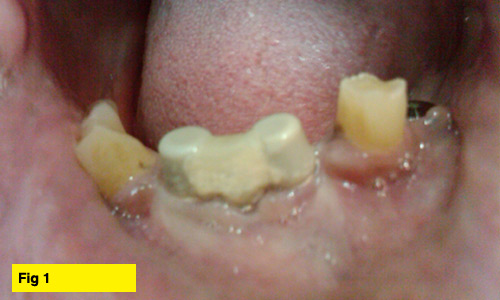Case Studies
Full Arch Restorations of the jaw with an immediate implant retained bridge
Dr Firdaus Hanapiah
BDS(Otago) MSc(Lon.) FDSRCS(Eng.)
Introduction
The destruction of teeth due to decay and natural wear doesn’t happen overnight but days ,months or even years. Patient who loses one or more teeth will resort to restore them with partial dentures. Sometimes when the patient is first seen by the dental surgeon, often enough, the condition is far too late to restore any of the teeth and the only solution is to remove all the teeth and restore it with a full denture or a full bridge retained by implants. The full denture would have its obvious disadvantages, therefore the best option would be the fix bridge retained by implants.
However the logistics is difficult in this case, as all the teeth need to be removed and a full denture needs to be placed. This will create great discomfort for the patient as he or she has to recover from placements of implant as well as to learn and adjust to the wearing of a full denture without any retention or support in the lower jaw.
The case report below will demonstrate how this problem can be circumnavigated if several teeth can be left behind and only to be extracted when the final restoration is ready to be fixed to the implants. The advantage of this is that the patient will still have some teeth to retain a lower partial denture.
Case Report
A 59 year old man came to our surgery requesting implants for his lower jaw. Upon examination we found that he had 4 poorly restored teeth with vertical fractures. It was decided that all the teeth needed to be removed and at least 5 implants to restore a full arch of a 12 unit bridge. It was decided also, that most of the teeth will be provisionally retained to support a partial denture as the patient objected to wearing a full denture during the healing time of the implants.

Fig 1. Shows poor state of existing teeth and anterior implants with provisional comfort caps.
After 3 months have passed, a final impression was taken to construct a final bridge, without extracting the existing teeth. The final impression was then sent to the lab and a full bridge was reconstructed and existing teeth were removed on the model, not dissimilar to the construction of an immediate denture.
On the day of the insertion of the bridge, the remaining teeth are removed and the abutments are placed using a custom made Duralay acrylic jig, to get an accurate seating of the bridge.

Fig 2. The bridge ready for insertion.

Fig 3. The Duralay jig placed to accurately seat the posterior abutments.

Fig 4. The teeth are extracted leaving behind the 5 implants with seated abutments.

Fig 5. Insertion of the permanent bridge immediately after extraction of the last four teeth.
After the bridge has been seated, the occlusion is then checked an adjusted. A final cementation is made to secure the bridge on the 5 implant abutments.
Conclusion
The mangement of a complex restoration case must take into consideration the transitional prosthesis that the patient has to wear during the healing period. The above technique described will make it easier for the patient to cope in his path towards the rehabilitation of his mouth with natural looking and fully functional teeth.